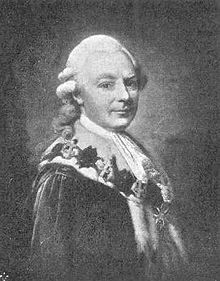Gustaf Philip Creutz
This article relies largely or entirely on a single source. (February 2012) |
This article includes a list of references, related reading, or external links, but its sources remain unclear because it lacks inline citations. (February 2012) |

Count Gustaf Philip Creutz (1 May 1731 in Anjala, now a part of Kouvola – 30 October 1785 in Stockholm), was a Swedish statesman, diplomat and poet. He was born in Finland and after concluding his studies at the Royal Academy of Turku he received a post in the Privy Council Chancery at Stockholm in 1751. Here he met Count Gyllenborg, with whom his name is indissolubly connected. They were closely allied with Mrs. Nordenflycht, and their works were published in common; to their own generation they seemed equal in fame, but posterity has given the palm of genius to Creutz.
His greatest work is contained in the 1762 volume, the idyll of Atis och Camilla; the exquisite little pastoral entitled Daphne was published at the same time, and Gyllenborg was the first to proclaim the supremacy of his friend.
In 1763 Creutz practically closed his poetical career; he went to Spain as ambassador, and after three years to Paris in the same capacity until May 1783, and it was during this time that Creutz met with the American resident in Paris at the time, Benjamin Franklin. So, as faith would have it, Sweden was the first country (after the UK) who recognized the young American republic, and Creutz and Franklin drafted the first Treaty of Amity and Commerce between the two nations.
In 1783 Gustav III recalled him and heaped honours upon him, but he died soon after. In 1784, he was elected a member of the Royal Swedish Academy of Sciences.
Atis och Camilla was long the most admired poem in the Swedish language; it is written in a spirit of pastoral which is now to some degree faded, but in comparison with most of the other productions of the time it is freshness itself. Creutz introduced a melody and grace into the Swedish tongue which it lacked before, and he has been styled the last artificer of the language.
See Creutz och Gyllenborgs Vitterhetsarbeten (Stockholm, 1795).
See also
References
- This article incorporates text from a publication now in the public domain: Chisholm, Hugh, ed. (1911). Encyclopædia Britannica (11th ed.). Cambridge University Press.
{{cite encyclopedia}}: Missing or empty|title=(help)
